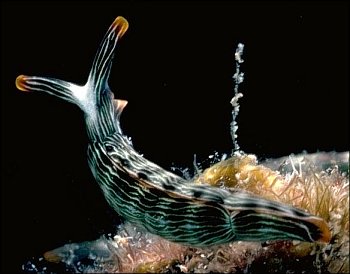
Thuridilla gracilis
(Risbec, 1928)
Order: SACOGLOSSA
Superfamily: ELYSIOIDEA
Family: Elysiidae
DISTRIBUTION
Western Pacific
PHOTO
UPPER RIGHT, LOWER LEFT: North point of Île Nou, Nouméa, New Caledonia, intertidal: 10 October 1988, AM C156617.
LOWER RIGHT: Pointe de Pandop, Koumac, New Caledonia, 20°35.2'S, 164°16.6'E, 2 m, hard substrate, 18 October 1993, 3 specimens (13, 20 & 24mm long alive), AM C200509.
PHOTOS: Bill Rudman.
Very characteristic colour pattern, with a dark, almost black, background, fine white longitudinal lines and the foot, head and rhinophores edged with bright orange. In some specimens the parapodia can also be bordered with bright orange and in some specimens elongate white or bright blue spots are present along the outside of the parapodia just down from the edge.Thuridilla bayeri is clearly a synonym and so is T. ratna.
Described by Risbec as having 8 rows of white streaks down the parapodia, which are bordered with orange. He also describes a whitish T-shaped mark on the head between the rhinophores. Gosliner (1995) discusses the synonymy of T. bayeri and T. ratna but considers that the original description of Risbec's Elysia gracilis is insufficient to allow an accurate identification. My photographs from New Caledonia clearly fit Risbec's description and painting, which I have reproduced below. Gosliner considers that the 10 denticles on the radular teeth in Risbec's description shows that E. gracilis is distinct from T. bayeri with 10-15 denticles. Considering the optical equipment available to Risbec to view these tiny teeth, I don't think this difference can be considered significant. I have retained the Thuridilla bayeri page as a cross-reference, but I feel that it is a synonym of T. gracilis.
Reference:
• Risbec, J. (1928) Contribution a l'etude des nudibranches Neo-Caledoniens. Faune de Colonies Francaises: Paris. 1-328.
• Gosliner, T.M. (1995) The genus Thuridilla (Opisthobranchia: Elysiidae) from the tropical Indo-Pacific, with a revision of ther phylogeny and systematics of the Elysiidae. Proceedings of the California Academy of Sciences, 49(1): 1-54.
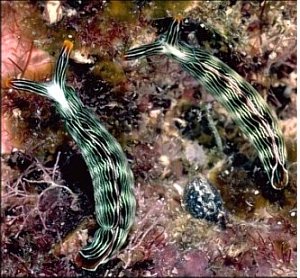
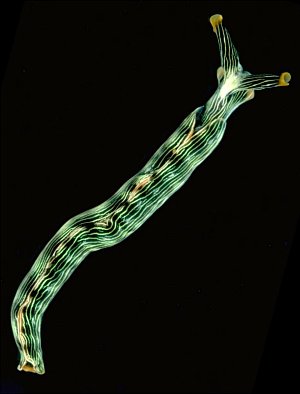
Rudman, W.B., 2000 (August 12) Thuridilla gracilis (Risbec, 1928). [In] Sea Slug Forum. Australian Museum, Sydney. Available from http://www.seaslugforum.net/find/thurgrac
Related messages
Thuridilla gracilis from S. E. Queensland
May 14, 2010
From: David Mullins
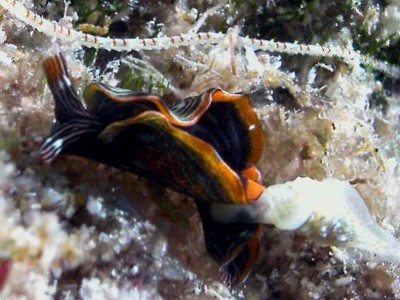
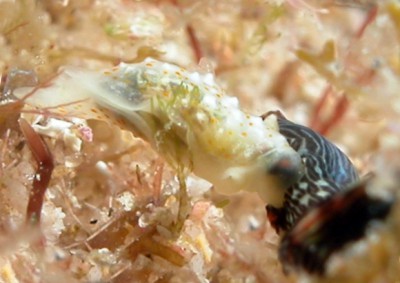
Concerning message #22294:
Dear Bill,
On a dive trip to Flinders Reef off Moreton Island last year we found this specimen of Thuridilla gracilis in a life and death struggle with a specimen of Gymnodoris okinawae.
The G. okinawae had a mouthful of parapodium which can be seen through it's transparent buccal wall. The Thuridilla dragged the Gymnodorid around and around at top speed for approximately half an hour before finally managing to shake it off losing a piece of the parapodium in the process.
The longitudinal white lines on the parapodia tend to have a greenish tinge above the blue ovals which changes to an orange margin. I can see where confusion can easily arise when trying to classify these creatures according to the coloured markings on their body. This is especially so when you are presented with a series of specimens that apparently show a graduation of pattern and colour that seemingly leads from one species into another.
Off Mooloolaba on the Gneering Shoals and at Mudjimba Island the most abundant species is (what we call) T. splendens seen in large numbers on every dive (see message #20630) but not T. neona at all. At Flinders Reef, a mere 50 kilometres to the south, we have not sighted T. splendens at all however T. neona is found on every dive and now this T. gracilis.
I don't know if any conclusions can be drawn from these observations?
Locality: Flinders Reef, off Moreton Island,, 10 metres, S. E. Queensland, Australia., Pacific Ocean, 06 March 2009, Coral encrusted Reef. Length: 12 mm. Photographer: David Mullins.
Kind regards,
David Mullins
marineimages@hotmail.com
Mullins, D.A., 2010 (May 14) Thuridilla gracilis from S. E. Queensland. [Message in] Sea Slug Forum. Australian Museum, Sydney. Available from http://www.seaslugforum.net/find/22324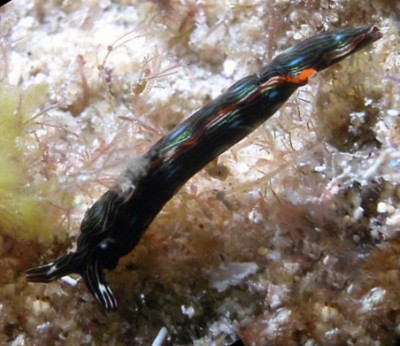
Dear David,
Thanks for the gymnodorid observation - they definitely seem to have no way of judging a 'suitable' prey size.
Concerning different 'species' at different localities. As you are no doubt aware I don't think we have got all the species of Thuridilla sorted out at present so it's a bit hard to be sure what we are discussing. Perhaps blue spots and blue patches are extremes of one species? If at least some species of Thuridilla have an abbreviated larval development then perhaps aggregations of 'look alikes', as you describe here, represent clusters of siblings which have not spread far from where they hatched? Just an idea ........
Best wishes,
Bill Rudman
Re: The foot of Thuridilla bayeri
May 14, 2010
From: John Fraser
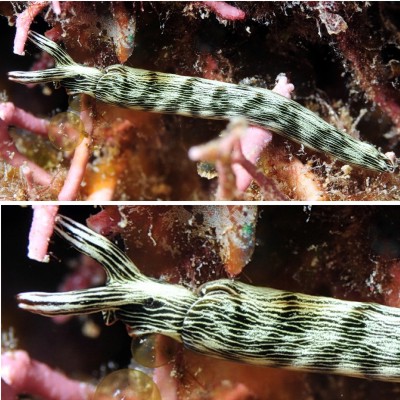
Concerning message #21136:
Has anyone done DNA or recent radular tooth studies on T. gracilis, T. bayeri and other similar slugs? Here in Laulau Bay, Saipan, I find both what were/are called T. gracilis and T. bayeri. I have heard there are "expert" studies that have grouped them together but I cannot find the studies. Can you provide me with any leads? here are a couple examples from Laulau Bay. They are quite common there.
Locality: Laulau Bay, 30-40 feet, Saipan, Northern Mariana Islands, Pacific, 11 Jan 2010 and 25 Jan 2010, sand and rubble. Length: 10-20 mm. Photographer: John Fraser.
Thanks
John Fraser
johnfraser1@gmail.com
Fraser, J., 2010 (May 14) Re: The foot of Thuridilla bayeri. [Message in] Sea Slug Forum. Australian Museum, Sydney. Available from http://www.seaslugforum.net/find/23356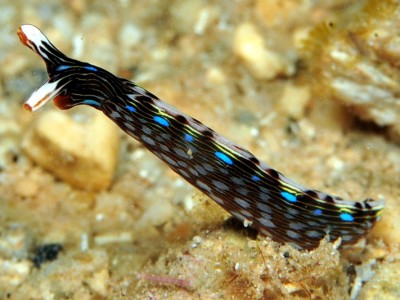
Dear John,
I discuss the T. gracilis - T. bayeri question on the T. gracilis Fact Sheet, where you will also find a reference to Gosliner's major review of the genus. Gosliner doesn't think T. gracilis is identifiable from its original description. However he considers an animal which has been named T. ratna (Marcus 1965), and has the same colour pattern as what I am calling T. gracilis, to be a colour form of the blue-spotted T. bayeri. So we both consider th blue-spotted and unspotted forms to be the same species. The difference is that I consider T. gracilis to be very recognisable from its original description, and as it is a much older name than T. bayeri I call the species by its oldest name - T. gracilis.
Have a look at the earlier messages attached to the T. gracilis Fact Sheet as they show the range in colour variation in the species and include an on-going discussion on the pros and cons of one or more species. For example, Clay Carlson tends towards two species. In many opisthobranchs there are taxonomic puzzles like this which will require more study before we have a definitive answer. If you have large populations of both then perhaps you could look for biological differences. Can you see consistent colour differences? Do they interbreed? Are their intermediate colour forms? Are their egg masses different? What do they eat? etc etc.
Best wishes,
Bill Rudman
Thuridilla gracilis from Lembeh, Indonesia.
March 4, 2009
From: Brian Mayes
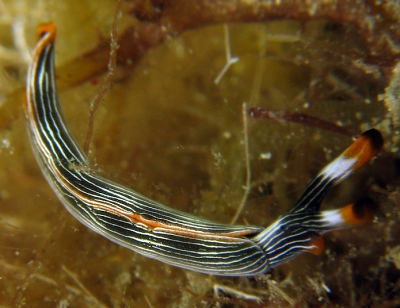
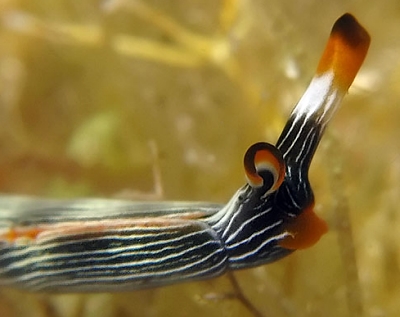
Dear Bill,
For comparison,I thought you may be interested in photos of Thuridilla gracilis from the Lembeh Straits in Sulawesi, Indonesia.
Locality: NAD Resort, Lembeh, 2 Metres, Sulawesi, Indonesia, Molucca Sea, 16 Jan 2009, Shallow weeds and silt.. Length: 20 mm. Photographer: Brian Mayes.
Kind Regards
Brian Mayes
brian.r.mayes@gmail.com
Mayes, B.R., 2009 (Mar 4) Thuridilla gracilis from Lembeh, Indonesia.. [Message in] Sea Slug Forum. Australian Museum, Sydney. Available from http://www.seaslugforum.net/find/22294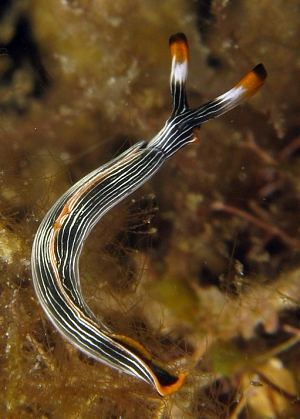
Dear Brian,
Any additional information on species of Thuridilla is welcome. Your animal seems a bit unusual in having black tips to the rhinophores. The only animal I can find with a similar colouration is one from Kenya in east Africa [#13784]
Best wishes,
Bill Rudman
Thuridilla bayeri ? from Bangka Island, Indonesia
October 13, 2008
From: Francois Zylberman
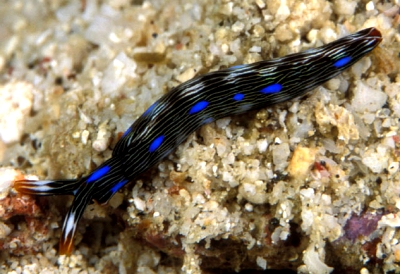
Dear Bill,
This specimen is like Thuridilla bayeri but I am not certain. Could you confirm ?
Locality: Bangka island, North Sulawesi, 10 - 20 m, Indonesia, 05 may 2006, corals and sand. Length: 30 - 40 mm. Photographer: Francois Zylberman.
Many thanks
Francois
francois@geodia.com
Zylberman, F., 2008 (Oct 13) Thuridilla bayeri ? from Bangka Island, Indonesia. [Message in] Sea Slug Forum. Australian Museum, Sydney. Available from http://www.seaslugforum.net/find/20774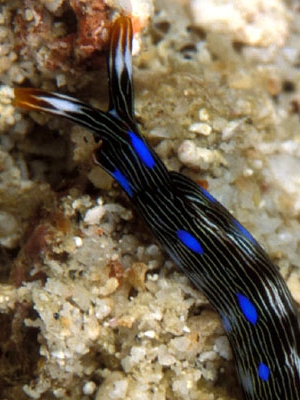
Dear Francois,
As you will see from the Fact Sheet and earlier messages, I consider this to be a form of Thuridilla gracilis. It is possible there is more than one species involved but the different colour patterns seem to merge into one another.
Best wishes,
Bill Rudman
Re: The foot of Thuridilla bayeri
December 3, 2007
From: Clay Carlson
Concerning message #21136:
Bill,
We could easily be dealing with color variations of Thuridilla gracilis though it seems odd that we don't run into intermediate forms on Guam. I don't know if we preserved this one for sequencing (if we preserved it at all). If so it would be good to get comparative data with a sure fire T. gracilis.
Clay
ccarlson@guam.net
Carlson, C. & Hoff, P.J., 2007 (Dec 3) Re: The foot of Thuridilla bayeri. [Message in] Sea Slug Forum. Australian Museum, Sydney. Available from http://www.seaslugforum.net/find/21239Clay,
Any new clues would indeed be welcome,
Bill
The foot of Thuridilla bayeri
November 30, 2007
From: Clay Carlson
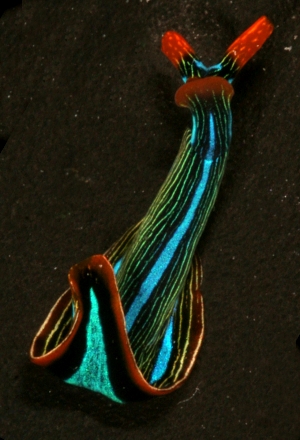
Bill,
This shows what can be done if one can teach their pet Thuridilla bayeri to 'roll over'.
Locality: Tulamben, 9 m, Bali, Indo-Pacific, 4 May 2006, black sand. Length: 13 mm. Photographer: Clay Carlson & Patty-Jo Hoff.
Clay Carlson & Patty-Jo Hoff.
ccarlson@guam.net
Carlson & Hoff, 2007 (Nov 30) The foot of Thuridilla bayeri. [Message in] Sea Slug Forum. Australian Museum, Sydney. Available from http://www.seaslugforum.net/find/21136Dear Clay,
I'll have to start calling you the 'slug whisperer'. As we have discussed before I have difficulty in knowing where T. bayeri ends and T. gracilis begins so I have kept them together under the older name. Hopefully more photos like this, and your earlier ones showing open parapodia [message #3077], may prove helpful. But I must say I find sorting T. bayeri, T. gracilis and T. splendens from one another a bit of a struggle.
Best wishes,
Bill Rudman
Possible colour variant of Thuridilla gracilis
October 16, 2007
From: Heidi Hösel
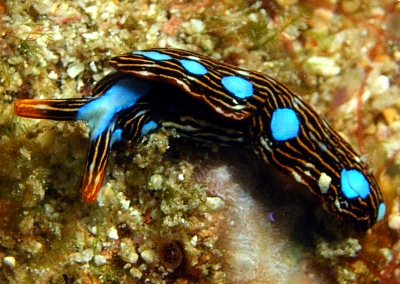
Dear Mr. Rudman
I have found this Elysiid during our holiday in West-papua. Except the blue patches, the pattern seem to ressembles closest to that of Thuridilla gracilis. I wonder whether this is a new colour variant of this species.
Locality: Maya's Cheese, Raja-Ampat-Islands, about 10 m, West-Papua, Indonesia, Pacific, 24 August 2007, coral slope. Length: about 2 cm. Photographer: Heidi Hösel.
Thank you in advance for your help
Heidi Hösel
hhoesel@gmx.de
Hösel, H., 2007 (Oct 16) Possible colour variant of Thuridilla gracilis. [Message in] Sea Slug Forum. Australian Museum, Sydney. Available from http://www.seaslugforum.net/find/20843Dear Heidi,
This is a variant which may have been called T. bayeri in the past [see message #19315], and the blue spots link it with some forms of T. splendens. I suspect we still have a bit of work to do on this genus.
Best wishes,
Bill Rudman
Thuridilla gracilis from West Papua
June 5, 2007
From: Wendy Atkinson
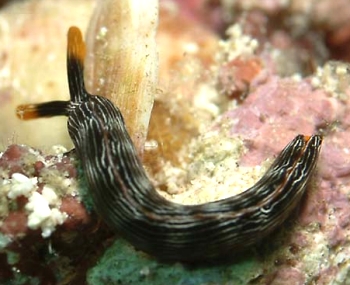
Hi
I think this may be a flat worm, but have had no luck ... could it possibly be a nudi?
Locality: Waterlogged dive site, 30-40 feet, Raja Ampat, West Papua, Indonesia Pacific Ocean, 11 November 26, sandy slope, mixed topo. Length: 10 mm.
Wendy
wendyatkinson@comcast.net
Atkinson, M.W., 2007 (Jun 5) Thuridilla gracilis from West Papua. [Message in] Sea Slug Forum. Australian Museum, Sydney. Available from http://www.seaslugforum.net/find/19176Dear Wendy,
This is a sacoglossan opishobranch Thuridilla gracilis
Best wishes,
Bill Rudman
Mating Thuridilla gracilis from nthn Mariana Islands
January 30, 2007
From: Yuji Fujie
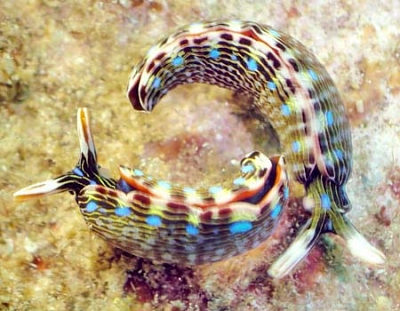
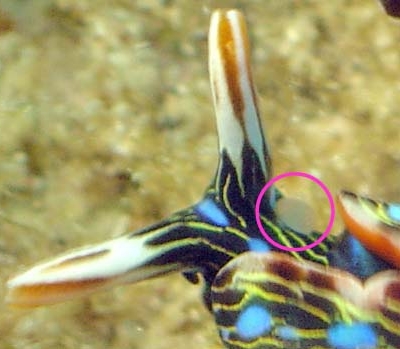
Dear Dr.Bill,
Here we have three pictures from maybe mating Thuridilla gracilis. They were spinning in the same place. This animal is very common in Saipan but I haven't seen them doing this behaviour before.
Locality: LauLau Beach, 6m, Saipan, Northern Mariana Islands, Pacific Ocean, 21 January 2007, on the dead coral. Length: 20mm. Photographer: Yuji Fujie.
Would you tell us what is the part inside circle, please ?
Best regards,
Yuji
dswith@isletwind.com
Yuji Fujie, 2007 (Jan 30) Mating Thuridilla gracilis from nthn Mariana Islands. [Message in] Sea Slug Forum. Australian Museum, Sydney. Available from http://www.seaslugforum.net/find/19315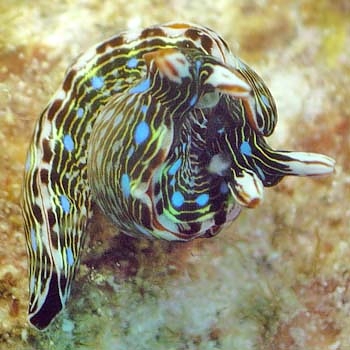
Dear Yuji,
Firstly this colour form is what some people would call Thuridilla bayeri [see message #3077]. I am pretty sure that the whitish lump on the right side, at the base of the rhinophore, which you have ringed, is the penis. Two elysiids twisted around each other like this - as you say 'spinning' - is almost ceratinly a mating or copulatory behaviour. In the photo alongside, both animals are wrapped around each other with their penises everted. I am not sure in the photo if the animals are trying to insert their penises into their partner's genital opening or whether they are trying to inject the sperm into the partner's body cavity. Quite a few sacoglossans practice hypodermis insemination in which sperm is transferred, not via the vagina but directly throught the body wall. Hopefully Kathe Jensen will be able to give us her opinion
Best wishes,
Bill Rudman
Sea grass hitch hiker
July 4, 2006
From: Charles Raabe
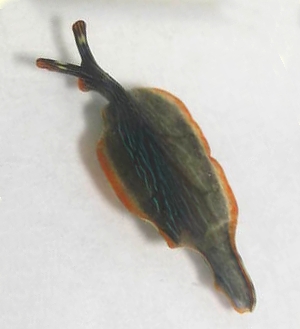
I am curious as to what species this is. While placing sea grass that I collected into my aquarium, I noticed this little guy.
Locality: Mactan Island, 2 feet, Philippines, Indo Pacific, 12 June 2006, Shallow sea grass bed. Length: 1 cm. Photographer: Charles Raabe.
Thank you for any help in its identification.
Charles Raabe
charlesr1958@pacific.net.ph
Raabe, C., 2006 (Jul 4) Sea grass hitch hiker. [Message in] Sea Slug Forum. Australian Museum, Sydney. Available from http://www.seaslugforum.net/find/16967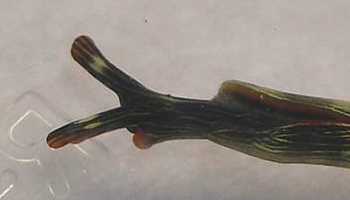
Dear Chuck,
There is still some confusion over the identity of some of these species, but I am pretty sure this is the elysiid sacoglossan Thuridilla gracilis.
Best wishes,
Bill Rudman
Thuridilla gracilis from Thailand
September 29, 2005
From: Nararongpon Sittithaweepat
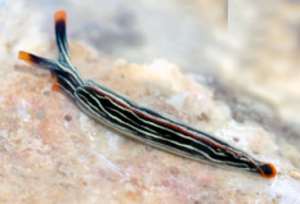
Dear Dr Rudman
I am studying nudibranchs at Kasetsart University in Thailand. I cannot identify some of them. I found this one at Mu Koh Angthong National Park. I think it is Thuridilla gracilis
Locality: Mu Koh Angthong National Park, Thailand. Gulf of Thailand. Depth: 5 m. Length: 20 mm. 9 August 2005. dead coral . Photographer: Narongpon Sittithaweepat
Thank you for your kindness
Narongpon Sittithaweepat
dorid44@yahoo.com
Narongpon Sittithaweepat, 2005 (Sep 29) Thuridilla gracilis from Thailand. [Message in] Sea Slug Forum. Australian Museum, Sydney. Available from http://www.seaslugforum.net/find/14835Dear Narongpon,
There is still some confusion about this group of species, but I would call this T. gracilis.
Best wishes,
Bill Rudman
Thuridilla from Mombasa, Kenya
May 18, 2005
From: Valérie Besnard
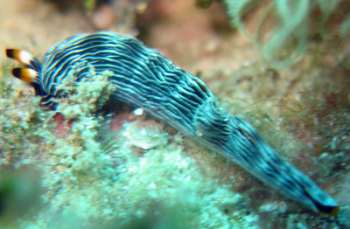
Dear Bill,
During a stay in Kenya (March 2005), I saw this sea slug that I couldn't identify: May be it is an elysiid or arminid?, but I'm not sure that this bad picture allowes any identification...
Diani, Mombasa south, 15 March 2005, size 5 cm, depth 12m, coral reef
Thank you very much for your help !
Best regards,
Valérie
Length:
valeriebesnard@aol.com
Besnard, V, 2005 (May 18) Thuridilla from Mombasa, Kenya. [Message in] Sea Slug Forum. Australian Museum, Sydney. Available from http://www.seaslugforum.net/find/13784Dear Valérie,
It is a species of the elysiid genus Thuridilla. There are still some problems in that genus, but your animal fits into a group I am identifying as Thuridilla gracilis, but there appears to be more than one species involved, but how to sort them out is still not clear.
Best wishes,
Bill Rudman
Thuridilla gracilis from Singapore
April 28, 2005
From: Lim Han Peng
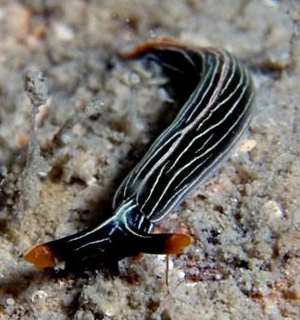
Hi Bill,
This Thuridilla gracilis are quite commonly found over here at Pulau Hantu, around the depth of 8-10 m.
Been spotted by friends for the past weeks diving there.
Locality: Pulau Hantu, Singapore. South China Sea. Depth: 10 m. Length: 20 mm. 17 Apr 2005, Sandy bottom. Photographer: H.P. Lim
Lim Han Peng
limhp@hotpop.com
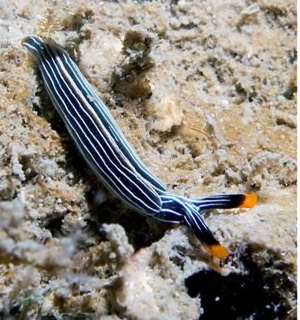
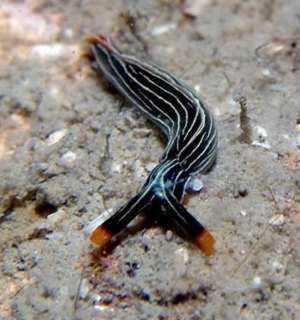
Dear hp,
This animal is very close to the colour form or 'species' which is known as Thuridilla bayeri (Marcus, 1965). However that colour form usually has a white band on the rhinophores below the orange tip. Clearly there is still some work to do on this colour group. Photos like this are a great help in building up more information on colour patterns.
Best wishes,
Bill Rudman
Thuridilla bayeri? found in tank
February 14, 2004
From: Marc
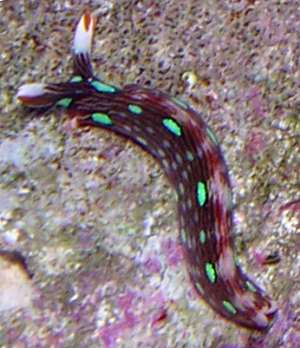
I found this little guy in my tank a few days ago. At first he was just hanging out on my back glass, and not moving at all, and now he is moving all over the live rock. My tank is a 20 Gallon High, the Live Rock is Tonga Deep water rock, and there is a 1.5" sand bottom in the tank.
Just curious what htis guy is, and wanted to make sure that he's okay for the tank, thanks for your help.
Marc
olsonmar@shu.edu
Marc, 2004 (Feb 14) Thuridilla bayeri? found in tank. [Message in] Sea Slug Forum. Australian Museum, Sydney. Available from http://www.seaslugforum.net/find/12206Dear Mark,
I assume that if it is on Tonga Live Rock then the rock came from Tonga? Your animal is a species of Thuridilla. I am not sure of the species as there is some confusion, at least in my mind, as to just how many species there are. Your animal looks quite like what has been called Thuridilla bayeri, with the blue? spots along the parapodia and the white band on the rhinophores. However if you look at the other photos on this page there seems to be a range of pattern between this and Thuridilla gracilis. I guess we will have to wait until more material is available.
Is it for your tank. Species of Thuridilla are herbivores. I presume it is growing in your tank so I guess its finding thinks to eat. Perhaps it can survive on the green algae covering your live rock. It certainly shouldn't harm other occupants in your aquarum.
Best wishes
Bill Rudman
Thuridilla from the Philippines
February 11, 2002
From: Erwin Köhler
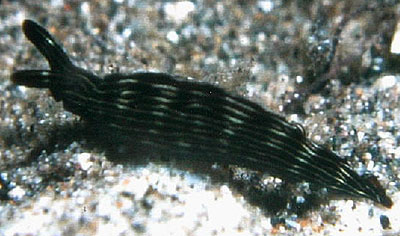
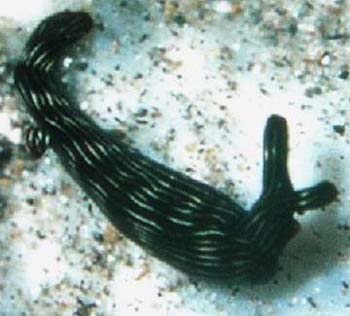
Dear Bill,
These shots were done by Fred Vogt [reticulata@gmx.net] in the Philippines, Negros Oriental Island, Sibulan, housereef. Length about 2 cm, depth 15 m, March 2000.
This animal looks like a very dark variant of Thuridilla gracilis.
Erwin
Erwin@medslugs.de
Köhler, E., 2002 (Feb 11) Thuridilla from the Philippines. [Message in] Sea Slug Forum. Australian Museum, Sydney. Available from http://www.seaslugforum.net/find/4805Dear Erwin,
I think you're right,
Best wishes,
Bill Rudman.
Thuridilla bayeri ? from the Seychelles
June 18, 2001
From: Erwin Köhler
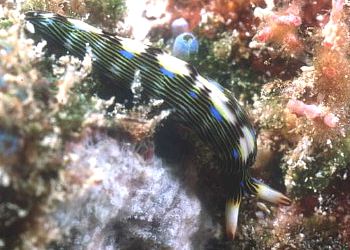
Dear Bill,
This one was made by Frank Gloystein (Frank.Gloystein@t-online.de) at the Seychelles, Bird Island on March 14, 2001, length about 2 cm, depth about 12 m.
Erwin
Erwin@medslugs.de
Köhler, E., 2001 (Jun 18) Thuridilla bayeri ? from the Seychelles. [Message in] Sea Slug Forum. Australian Museum, Sydney. Available from http://www.seaslugforum.net/find/4568Dear Erwin,
As I discuss at the top of the page, this is the Thuridilla bayeri form of T. gracilis.
Best wishes,
Bill Rudman
Re: Thuridilla gracilis from the Solomon Ids
June 16, 2001
From: Kathe R. Jensen
Dear Bill,
I don't know what Terry would call this one, but it is definitely not what I would call T. ratna. In T. ratna the white stripes do not extend into the red/orange terminal bands on the rhinophores (and there are no iridescent blue spots on external surface of parapodia - as in Bruce Potter's photo).
Greetings,
Kathe
jensen@ait.ac.th
Jensen, K., 2001 (Jun 16) Re: Thuridilla gracilis from the Solomon Ids. [Message in] Sea Slug Forum. Australian Museum, Sydney. Available from http://www.seaslugforum.net/find/4604Dear Kathe,
I can't see any blue spots on Bruce's photo. I also thought that I some specimesn of 'T. ratna' the white lines on the rhinophores did not coalesce into a submarginal white band. Basically it seems there are still a few points to sort out with this genus.
Best wishes,
Bill Rudman
Thuridilla gracilis from the Solomon Ids
June 15, 2001
From: Bruce Potter
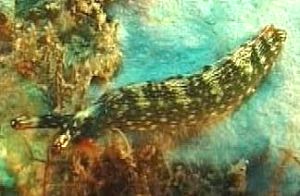
Bill,
I frequently see small Thuridilla-shaped slugs here, and many are too small to get good video images of.
This one was about 15mm long, and so the image is not good, but perhaps good enough to identify? It was at the Bonegi 1 dive site, just outside of Honiara in the Solomon Islands, and was found at about 7 meters on rubble.
Regards
Bruce Potter
bruce.potter@adventist.org.sb
Potter, B., 2001 (Jun 15) Thuridilla gracilis from the Solomon Ids. [Message in] Sea Slug Forum. Australian Museum, Sydney. Available from http://www.seaslugforum.net/find/4359Dear Bruce,
This is what I am calling Thuridilla gracilis and what Terry Gosliner identifies as the 'T. ratna' form of T. bayeri.
Best wishes,
Bill Rudman
Thuridilla gracilis from Coral Sea
October 29, 2000
From: Des Paroz
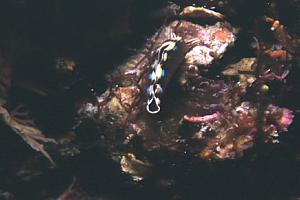
Hi Bill
I found this slug on a recent trip to the Coral Sea, at Flinders Reef. The specific dive site was Trigger Happy, and the animal was in about 18m.
Sorry about the poor quality of the photo - some battery probs meant the TTL didn't quite happen properly, so the shot is a bit underexposed.
Appreciate any help in identifying this critter.
Best regards
Des Paroz
www.divesite.paroz.com
des@paroz.com
Paroz, D., 2000 (Oct 29) Thuridilla gracilis from Coral Sea. [Message in] Sea Slug Forum. Australian Museum, Sydney. Available from http://www.seaslugforum.net/find/3150Dear Des,
This is the T. bayeri colour form of Thuridilla gracilis.
Bill Rudman.
Thuridilla bayeri & T. gracilis
September 28, 2000
From: C. Carlson & P.J. Hoff
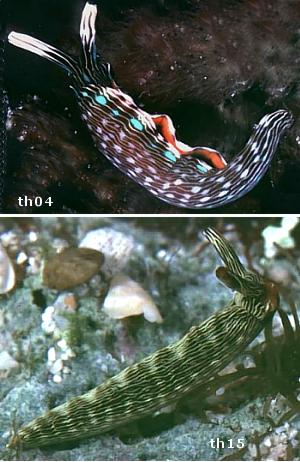
UPPER RIGHT: th04 - Thuridilla bayeri colour form, 16mm; Bile Bay, Guam, 5m; 11 October 1975. th15 - Thuridilla gracilis colour form, 18mm; Cetti Bay, Guam, reef flat; 30 November 1985.
LOWER LEFT: th04 - open parapodia of Thuridilla bayeri colour form, 14mm; Guam, Apra Harbor, Sponge Mound, 21m, 5 July 1988.
LOWER RIGHT: th15 - Thuridilla gracilis colour form, 20mm; Mactan, Cebu, Philippines. depth?; 29 April 1997.
Dear Bill,
Concerning the question of whether Thuridilla bayeri and Thuridilla gracilis are distinct species. We have tended to keep them separate, based upon the blue spotting along the sides of 'T. bayeri' as well as the coloring differences inside the the parapodia. The 'T. bayeri' form shown here is one of the few that we have seen that has torquiose spots on the side of the parapodia. Generally we find dark blue. This would be a good pair for some
sequencing.
Clay & Patty Jo
clay.carlson@kuentos.guam.net
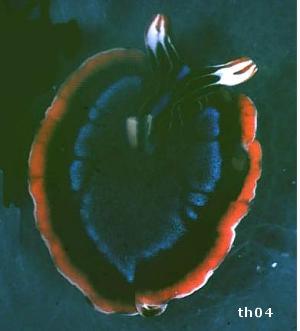
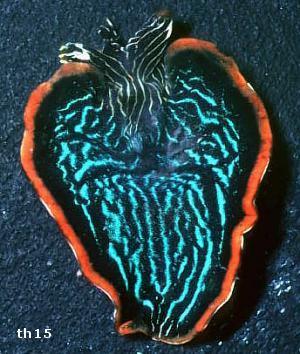
Dear Clay & Patty Jo,
Thanks for the photos. There are two questions which need resolving.
• Are the two distinct species?
• Is Risbec's description of T. gracilis sufficient for us to identify it?
Best wishes,
Bill Rudman.
Thuridilla from coral rock
September 24, 2000
From: Andrew Trevor-Jones
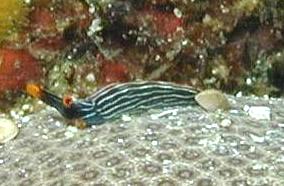
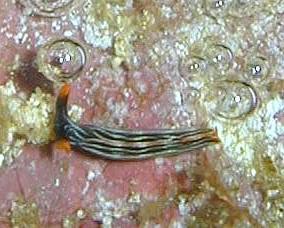
Please confirm the pictures are of Thuridilla bayeri. These came as hitchikers on coral rock from the Great Barrier Reef, Queensland. Exact locality unknown.
Andrew Trevor-Jones
atj777@attglobal.net
Trevor-Jones, A., 2000 (Sep 24) Thuridilla from coral rock. [Message in] Sea Slug Forum. Australian Museum, Sydney. Available from http://www.seaslugforum.net/find/3056Dear Andrew,
This is what has been identified as Thuridilla bayeri, but I think the earliest name for it is Thuridilla gracilis.
Best wishes,
Bill Rudman.
Thuridilla gracilis from Great Barrier Reef
August 12, 2000
From: Stuart Hutchison
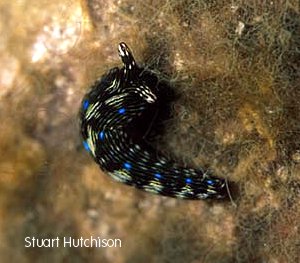
Dear Bill,
Do you know what species this is?
It was found at 8m on mossy rock at Flinders Reef (Great Barrier Reef - Australia) in March 2000.
Stuart Hutchison
hutchco@tpg.com.au
Hutchison, S., 2000 (Aug 12) Thuridilla gracilis from Great Barrier Reef. [Message in] Sea Slug Forum. Australian Museum, Sydney. Available from http://www.seaslugforum.net/find/2869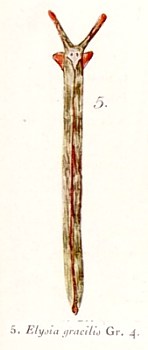
Dear Stuart,
This is a sacoglossan rather than a nudibranch. It belongs to a 'species' or group of species with white lines or rows of white streaks down the parapodia and body. Sometimes there is an orange border to the parapodia and foot, and the tips of the rhinophores are orange, and sometimes there is a row of blue streaks near the parapodial edge. Your animal is one that lacks the orange but has the blue spots.
As I explain at the top of the page, a recent review of the genus (Gosliner, 1995) identifies this as Thuridilla bayeri, but if the range of colour variation doess belong to one species, then the earliest name for this species must be Risbec's T. gracilis. I have posted a copy of Risbec's painting [Pl.10,fig 5] alongside.
Best wishes,
Bill Rudman.
